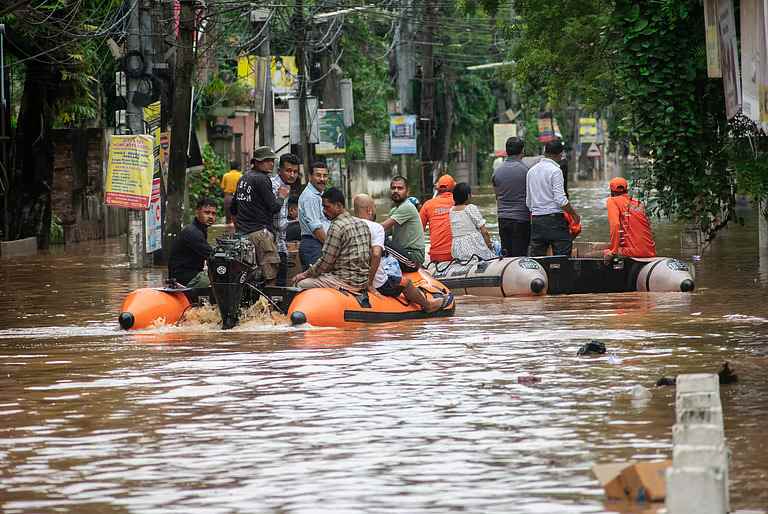Corporate Social Responsibility (CSR) has lately managed to make its presence in most of the business as one small department or unit, which is highly commendable. There are less than 10 countries like Nepal, India which have made CSR mandatory. In recent times, CSR has evolved and formalized its structure into the private sector.
The notable initiatives by the Government of Nepal to streamline CSR in the country is the introduction of Industrial Enterprise Act (2020), Industrial Enterprise Rules (2022) and Nepal Rastra Bank’s Unified Directives (2021). Now, slowly CSR is considered an integral part of business strategies. The core principle of CSR is for businesses to contribute to society and the environment in an ethical manner.
The major areas dedicated to CSR are education; health; natural disaster management; environment protection; preservation of arts, culture & heritage; livelihood development through skills building.
CSR activities and disaster response
CSR activities and disaster response have become synonyms. When there is any kind of disaster that happens anywhere after the state/ government, its private sector or philanthropists who are looked upon for the support, relief & management.However, the sector is only viewed as a channel for disaster relief & response work rather than risk reduction and management. As per the research of some prominent agencies, it’s said investing $1 in resilience & management saves $4–7 in response.
Nepal is one of the disaster prone countries, with the vast majority of the population exposed to extreme impacts of floods, landslides, heatwaves, storms, droughts and earthquakes. The country suffers from 500 disasters on an average annually, ranging from small to large scale (NPC, 2019). Nepal is also one of the highly climate-sensitive geography with high susceptibility to the impacts of climate change.
This condition creates an immense need for the private sector in Nepal to actively work on disaster management, especially on risk reduction. During 2015, Gorkha Earthquake – 7.8 magnitude earthquake struck Nepal, one of the worst disasters the country had seen in eight decades, which killed about 9000 people, injured more than 20 thousand people and displaced 3.5 million people.
During this time, the country had seen huge engagement of the private sector- SMES to big corporate houses coming together for relief & response. Chaudhary Group, the leading business conglomerate of Nepal, provided a huge number of relief items, built 3000 transitional shelters, schools and integrated villages.
They formed a dedicated team from their corporate office to look into the Earthquake Management work for almost 1.5 years of their rebuilding efforts. Their efforts in earthquake rehabilitation proved to be a case study for Harvard Business School on the role of the private sector in disaster management.
Similarly, other private sectors like Batas Group, Bhat Bhateni Super Market and many small businesses played pivotal role in post-earthquake management in 2015. Given that NPR 1.74 billion was transferred to the Prime Minister’s Natural Disaster Relief Fund following the earthquake, the business sector is renowned for its generosity in aiding the government’s post-disaster efforts. Now almost after a decade of the earthquake as well as legal requirement of mandatory CSR in Nepal, significant good work towards aligning CSR with national priority of disaster management has been observed.
It is without a doubt that natural disasters adversely affect the country’s economy. The 2015 earthquake reportedly hit the country’s GDP with USD 5.17 billion/ NPR 648 billion loss and from 2018 to 2024, more than 32,000 small and large-scale natural disasters were recorded and the economic damage during that time period amounted to NPR 23.60 billion (MoHA, 2024). Although no proper overall data is recorded for the losses incurred by the private sector due disasters, direct and indirect impacts are severely felt by the industries even though they have aided in emergency responses during such events.
Crucial role played by Strategic CSR
This is where strategic CSR plays a crucial role. Strategic CSR refers to when businesses integrate social and environmental impacts in its core principles that ultimately results in the wellbeing of the society. This approach of CSR differs from the traditional approach because it focuses on long-term impacts, values stakeholder engagements, aligns goals with social and environmental benefits, and integrates sustainable strategies into business goals rather than operating separately.
It is all about creating win-win for both the corporate and the state. As per Doing Good Index 2024 on Nepal, it says only 43% of community based organizations feel trusted by corporates and less than 35% SDOs (Social Delivery Organizations) receive corporate funding. Here a huge opportunity for strategic alignment can be seen to bridge the work between SDO working on Disaster Management & Corporate through CSR.
Business Continuity Management
Business Continuity Management (BCM) and Business Continuity Plan (BCP) is one of the good means to create the strategic alignment of the private sector in disaster management. Here, BCM & BCP describes plans, protocols, and roles for dealing with and recovering from any disaster, covering all facets of the company, including employees, suppliers, processes and community.
Asian Disaster Preparedness Center- Nepal conducted the first ToT on Business Continuity Management (BCM) training in 2018. Similarly, more than 300 businesses were able to understand, develop and adopt BCM and BCPs through USAID Tayar Nepal Project as well as more than 40 women entrepreneurs were trained to upscale their natural resources-based businesses like horticulture to be disaster resilient (USAID, n.d.).
Strategic alignment to reduce disaster induced damages
Nepal’s ecosystem seems to have all it takes to have strategic alignment to have disaster management through strategic CSR where we lack leadership & collaboration with higher authority levels. Businesses can reduce catastrophe-related losses and damages, increase community resilience, assist the public when needed, and fulfill state law’s CSR requirements by implementing strategic CSR for disaster management.
For example, industries situated in flood-prone areas can take data from monsoon forecasts to map out their BCP & BCM for the year ahead and take preventive measures which in turn can be shared and collaborated with local authorities. They can then jointly work with local authorities and other non-governmental bodies on disaster risk reduction and preparedness for the surrounding communities by providing shelters, doing awareness programs, developing early warning systems, etc.
Post major hurricane in 2005, WalMart have created an Emergency Operation Center (EOC) that not only keeps their business in check, they also ensure enough supplies in disaster prone areas both for retail as well as relief. Private sector has shown their contributions towards disaster risk reduction and managemen,t and for them to further utilize their potential through strategic CSR, it is vital for the government to address bottlenecks in policies and practices.
Disaster, especially climate induced disasters such as floods and heat waves are increasing day by day. So, it’s high time to work on strategic alignment to reduce disaster induced damages & losses. Thus, it is important for the private sector to understand and incorporate strategic CSR, with a focus on disaster risk reduction and preparedness. This is vital especially for a disaster-vulnerable country like Nepal as it helps the private sector minimize their losses, contribute to the global fight against climate change, collaborate with other sectors and ultimately work for the betterment of the society.
Views of the author are personal and do not necessarily represent the website’s views.
 Author of the above article Merina Ranjit leads Chaudhary Foundation, social development initiative of Nepal’s leading conglomerate Chaudhary Group (CG). She has 15 years of experience spanning in social development, social enterprise and environmental management. Her impactful achievements in social development are testament to her visionary leadership where she have lead major Post Disaster Management Project after 2015 April Earthquake where they built around 3000 Transitional shelter, 40 schools and an Integrated Village with 62 permanent homes, Baliyo Nepal Project – Nutrition Initiative, Unnati Cultural Village- Social Enterprise to connect Nepalese Art and Craft sector to Global Market.
Author of the above article Merina Ranjit leads Chaudhary Foundation, social development initiative of Nepal’s leading conglomerate Chaudhary Group (CG). She has 15 years of experience spanning in social development, social enterprise and environmental management. Her impactful achievements in social development are testament to her visionary leadership where she have lead major Post Disaster Management Project after 2015 April Earthquake where they built around 3000 Transitional shelter, 40 schools and an Integrated Village with 62 permanent homes, Baliyo Nepal Project – Nutrition Initiative, Unnati Cultural Village- Social Enterprise to connect Nepalese Art and Craft sector to Global Market.


